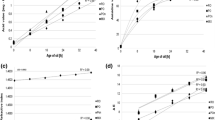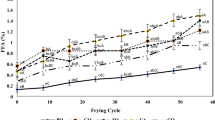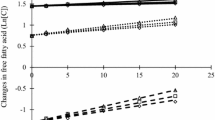Abstract
Changes occurring in refined olive pomace oil (ROPO) blended with refined palm oil (RPO) during repeated frying cycles were monitored. Four ratios of ROPO/RPO blends were prepared: (100:0), (75:25), (50:50) and (25:75). The effect of deep-frying was studied by assessing the changes in iodine value, acid value, color value and fatty acids composition. The results show that the mixture ROPO/RPO (25:75) is the most stable compared with other blends. The fate of 3-MCPD and glycidyl esters during deep-frying was investigated showing no endogenous formation of the esters during 16 h of deep-frying.
Similar content being viewed by others
Abbreviations
- GE:
-
Glycidyl ester(s)
- 3-MCPD:
-
3-Monochloropropane-1,2-diol
- AV:
-
Acid value
- IV:
-
Iodine value
- ROPO:
-
Refined olive pomace oil
- RPO:
-
Refined palm oil
References
Lalas S, Dourtoglou V (2003) Use of rosemary extract in preventing oxidation during deep-fat frying of potato chips. J Am Oil Chem Soc 80:579–583
Chen WA, Chiu CP, Cheng WC, Hsu CK, Kuo MI (2013) Total polar compounds and acid values of repeatedly used frying oils measured by standard and rapid methods. J Food Drug Anal 21:58–65
Mildner-Szkudlarz S, Jeleń HH, Zawirska-Wojtasiak R, Wąsowicz E (2003) Application of headspace-solid phase microextraction and multivariate analysis for plant oils differentiation. Food Chem 83:515–522
Man YBC, Jaswir I (2000) Effect of rosemary and sage extracts on frying performance of refined, bleached and deodorized (RBD) palm olein during deep-fat frying. Food Chem 69:301–307
Zribi A, Jabeur H, Aladedunye F, Rebai A, Matthäus B, Bouaziz M (2014) Monitoring of quality and stability characteristics and fatty acid compositions of refined olive and seed oils during repeated pan-and deep-frying using GC, FT-NIRS, and chemometrics. J Agric Food Chem 62:10357–10367
Zribi A, Jabeur H, Matthäus B, Bouaziz M (2016) Quality control of refined oils mixed with palm oil during repeated deep-frying using FT-NIRS, GC, HPLC, and multivariate analysis. Eur J Lipid Sci Technol 118:512–523
Zribi A, Jabeur H, Flamini G, Bouaziz M (2016) Quality assessment of refined oil blends during repeated deep frying monitored by SPME–GC–EIMS, GC and chemometrics. Int J Food Sci Technol 51:1594–1603
Juárez MD, Osawa CC, Acuña ME, Sammán N, Gonçalves LAG (2011) Degradation in soybean oil, sunflower oil and partially hydrogenated fats after food frying, monitored by conventional and unconventional methods. Food Control 22:1920–1927
Zhang Q, Saleh ASM, Chen J, Shen Q (2012) Chemical alterations taken place during deep-fat frying based on certain reaction products: a review. Chem Phys Lipids 165:662–681
Santos CSP, Cruz R, Cunha SC, Casal S (2013) Effect of cooking on olive oil quality attributes. Food Res Int 54:2016–2024
Mlcek J, Druzbikova H, Valasek P, Sochor J, Juríková T, Borkovcová M, Baron M, Balla S (2015) Assessment of total polar materials in frying fats from Czech restaurants. Ital J Food Sci 27:160–165
Zelinková Z, Svejkovská Velíšek B, Doležal JM (2006) Fatty acid esters of 3-chloropropane-1,2-diol in edible oils. Food Addit Contam 23:1290–1298
Velisek J, Davidek J, KubelkaV Bartosova J, Tuckova A, Hajslova J, Janicek G (1979) Formation of volatile chlorohydrins from glycerol (triacetin, tributyrin) and hydrochloric acid. Lebensm Wiss Technol 12:234–236
International Agency for Research on Cancer Monographs on the evaluation of carcinogenic risk to humans; IARC, 2012
Weißhaar R (2008) 3-MCPD-esters in edible fats and oils–a new and worldwide problem. Eur J Lipid Sci Technol 110:671–672
Doležal M, Zelinková Z, Velíšek J (2008) In 6th Euro Fed Lipid Congress, Athens, Greece., vol. 7, p. 9
Leonardi M (2005) New blends of frying vegetable oils. Riv Ital Delle Sostanze Grasse 82:71–81
Chantzos NV, Georgiou CA (2007) Monitoring lipid oxidation events at frying temperatures through radical scavenging assays. Chem Ind Chem Eng Q 13:163–166
Rossell JB (2001) Frying: improving quality, vol 56. Woodhead, Cambridge
DGF Deutsche Einheitsmethoden zur Untersuchung von Fetten.Fettprodukten. (2013)Tensiden und verwandten Stoffen. Wissenschaftliche Verlagsgesellschaft. Sttutgart, Germany. (n.d.)
International Olive Council (2001) Preparation of the fatty acid methyl esters from olive oil and olive pomace oil. (IOC). COI/T, 20/Doc. No. 24
International Olive Council (2001) Determination of trans unsaturated fatty acids by capillary column gas chromatography. (IOC). COI/T, 20/Doc. No. 17/Rev. 1
DGF Standard Method C-VI 18 Fatty-acid-bound 3-chloropropane-1,2-diol (3-MCPD) and 2,3-epoxipropane-1-ol (glycidol). (2011) Determination in oils and fats by GC/MS (Differential measurement). In: Deutsche Einheitsmethoden zur Untersuchung von Fetten, Fettp. (n.d.)
Abdulkarim SM, Long K, Lai OM, Muhammad SKS, Ghazali HM (2007) Frying quality and stability of high-oleic Moringa oleifera seed oil in comparison with other vegetable oils. Food Chem 105:1382–1389
Zribi A, Gargouri B, Jabeur H, Rebaï A, Abdelhedi R, Bouaziz M (2013) Enrichment of pan-frying refined oils with olive leaf phenolic rich extract to extend the usage life. Eur J Lipid Sci Technol 115:1443–1453
Wagner KH, Elmadfa I (2011) Nutrient antioxidants and stability of frying oil (thocochromanols, β-carotene, philloquinone, ubiquinone 50, and arcorbyl palmitate. In: Boskou D, Elmadfa I (eds) Frying of foods: oxidation, nutrient and non-nutrient antioxidants, biologically active compounds and high temperatures, 2nd edn. Taylor and Francis Group, Boca Raton, pp 177–197
Otunola GA, Adebayo GB, Olufemi OG (2009) Evaluation of some physicochemical parameters of selected brands of vegetable oils sold in Ilorin metropolis. Int J Phys Sci 4:327–329
Tynek M, Hazuka Z, Pawlowicz R, Dudek M (2001) Changes in the frying medium during deep-frying of food rich in proteins and carbohydrates. J Food Lipids 8(251):261
Gertz C, Stier RF (2013) 7th International symposium on deep-fat frying, San Francisco, CA (USA): recommendations to enhance frying. Eur J Lipid Sci Technol 115:589–590
Debnath S, Rastogi NK, Krishna AGG, Lokesh BR (2012) Effect of frying cycles on physical, chemical and heat transfer quality of rice bran oil during deep-fat frying of poori: an Indian traditional fried food. Food Bioprod Process 90:249–256
Chung J, Lee J, Choe E (2004) Oxidative stability of soybean and sesame oil mixture during frying of flour dough. Food Sci 69:574–578
Arslan FN, Şapçı AN, Duru Fatma, Kara H (2016) A study on monitoring of frying performance and oxidative stability of cottonseed and palm oil blends in comparison with original oils. Int J Food Prop. doi:10.1080/10942912.2016.1177544
Velasco J, Marmesat S, Dobarganes CM (2008) Chemistry of frying, chap 3. In: Advances in deep-fat frying of foods, p 33
Sumnu SG, Sahin S (2008) Advances in deep-fat frying of foods. CRC Press, Boca Raton
Fan HY, Sharifudin MS, Hasmadi M, Chew HM (2012) Frying stability of rice bran oil and palm olein. Int Food Res J 20:403–407
Chatzilazarou A, Gortzi O, Lalas S, Zoidis E, Tsaknis J (2006) Physicochemical changes of olive oil and selected vegetable oils during frying. J Food Lipids 13:27–35
Mishra R, Sharma HK (2014) Effect of frying conditions on the physico-chemical properties of rice bran oil and its blended oil. Food Sci Technol Int 51:1076–1084
Farhoosh R, Kenari RE, Poorazrang H (2009) Frying stability of canola oil blended with palm olein, olive, and corn oils. J Am Soc 86:71–76
Matthäus B, Pudel F, Fehling P, Vosmann Freudenstein KA (2011) Strategies for the reduction of 3-MCPD esters and related compounds in vegetable oils. Eur J Lipid Sci Technol 113:380–386
Franke K, Strijowski U, Fleck G, Pudel F (2009) Influence of chemical refining process and oil type on bound 3-chloro-1, 2-propanediol contents in palm oil and rapeseed oil. Lwt-Food Sci Technol 42:1751–1754
Kuhlmann J (2011) Determination of bound2,3-epoxy-1-propanol (glycidol) and bound monochloropropanediol (MCPD) in refined oils. Eur J Lipid Sci Technol 113:335–344
Weißhaar R, Perz R (2010) Fatty acid esters of glycidol in refined fats and oils. Eur J Lipid Sci Technol 112:158–165
Bakhiya N, Abraham K, Gürtler R, Appel Lampen KEA (2011) Toxicological assessment of 3-chloropropane-1,2-diol and glycidol fatty acid esters in food. Mol Nutr Food Res 55:509–521
Masukawa Y, Shiro H, Kondo N, Kudo N (2011) Generalized method to quantify glycidol fatty acid esters in edible oils. J Am Oil Chem Soc 88:15–21
Haines TD, Adlaf KJ, Pierceall RM, Lee I, Venkitasubramanian P, Collison MW (2011) Direct determination of MCPD fatty acid esters and glycidyl fatty acid esters in vegetable oils by LC–TOFMS. J Am Oil Chem Soc 88:1–14
Aniołowska M, Kita A (2016) The effect of frying on glycidyl esters content in palm oil. Food Chem 203:95–103
BfR (Bundesinstitut für Risikobewertung). Initial evaluation of the assessment of levels of glycidol fatty acid esters detected in refined vegetable fats, BfR Opinion No. 007/2009, March10, 2009. http://www.bfr.bund.de/cm/245/initialevaluationoftheassessmentoflevelsofglycidolfattyacidesters.pdf Accessed Aug 2015
Wong YH, Muhamad H, Abas F, Lai OM, Nyam KL, Tan ChP (2016) Effects of temperature and NaCl on the formation of 3-MCPD esters and glycidyl esters in refined, bleached and deodorized palmolein during deep-fat frying of potato chips. Food Chem 219:126–130
ILSI Europe (2009). Summary report of a workshop on ‘‘3-MCPD Esters in Food Products”. Brussels: ILSI Europe Report Series. Available from URL: http://www.ilsi.org/Europe/Publications/Final%20version%203%20MCPD%20esters.pdf. Last Accessed 28 Oct 2014
Dingel A, Matissek R (2015) Esters of 3-monochloropropane-1,2-diol and glycidol: no formation by deep frying during large-scale production of potato crisps. Eur Food Res Technol 241:719–723
Aniołowska M, Kita A (2015) The effect of type of oil and degree of degradation on glycidyl Esters content during the frying of French fries. J Am Oil Chem Soc 92:1621–1631
Zhou H, Jin Q, Wang X, Xu X (2013) Effects of temperature and water content on the formation of 3-chloropropane-1,2-diol fatty acid esters in palm oil under conditions simulating deep fat frying. Eur Food Res Technol 238:495–501
Acknowledgements
The authors would like to thank the “Ministère de l’Enseignement Supérieur et de la Recherche Scientifique” (Laboratory LR14ES08), Tunisia, for its financial support to this research work.
Author information
Authors and Affiliations
Corresponding author
Ethics declarations
Conflict of interest
The authors declare no competing financial interest.
Compliance with ethics requirements
This article does not contain any studies with human or animal subjects.
Rights and permissions
About this article
Cite this article
Ben Hammouda, I., Zribi, A., Ben Mansour, A. et al. Effect of deep-frying on 3-MCPD esters and glycidyl esters contents and quality control of refined olive pomace oil blended with refined palm oil. Eur Food Res Technol 243, 1219–1227 (2017). https://doi.org/10.1007/s00217-016-2836-4
Received:
Revised:
Accepted:
Published:
Issue Date:
DOI: https://doi.org/10.1007/s00217-016-2836-4




